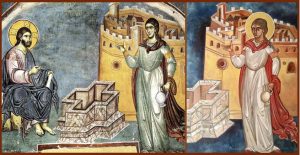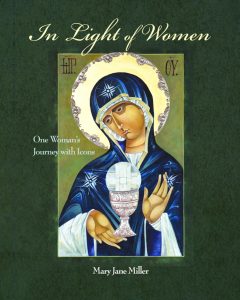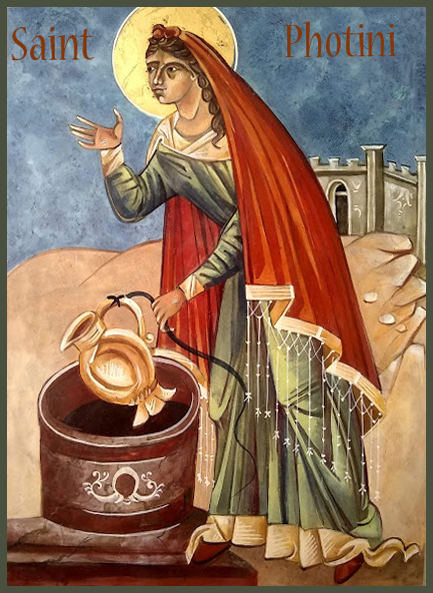
By Mary Jane Miller
The longest documented conversation Jesus had with anyone was with Photini, The Samaritan woman at the Well. Her life was radically changed and, by tradition, she later becomes a disciple, partner and evangelist. Jesus tore down barriers all the time but particularly in his lack of distinction between genders. He spoke to whomever he needed to speak with, he broke social norms and turned the predictable upside down. Christ is the example of God walking in the world beside all of us equally with no hesitation.
In two recent iconography workshops I had the privilege to teach two groups how to paint the icon of the Samaritan at the Well. The discussions that transpired over five days in Lewes, Delaware with St. Peter’s and then in Lufkin Texas with St. Cyrian’s were life changing. Both classes talked about the many messages revealed through this wonderful story. While painting in egg tempera, we took apart and put back together the symbolism and structure of the entire icon.
The story from John 4: 4-42
A Samaritan woman came to draw water, and Jesus said to her, “Give me a drink.” The Samaritan woman said to him, “How is it that you, a Jew, ask a drink of me, a woman of Samaria?” Jesus answered her, “If you knew the gift of God, and who it is that is saying to you, ‘Give me a drink’, you would have asked him, and he would have given you living water.” The woman said to him, “Sir, you have no bucket, and the well is deep. Where do you get that living water? Are you greater than our ancestor Jacob, who gave us the well, and with his sons and his flocks drank from it?” Jesus said to her, “Everyone who drinks of this water will be thirsty again, but those who drink of the water that I will give them will never be thirsty. The water that I will give will become in them a spring of water gushing up to eternal life.” The woman said to him, “Sir, give me this water, so that I may never be thirsty or have to keep coming here to draw water.”
Jesus said to her, “Go, call your husband, and come back.” The woman answered him, “I have no husband.” Jesus said to her, “You are right in saying, ‘I have no husband’; for you have had five husbands, and the man you are now living with is not your husband. What you have said is true!” The woman said to him, “Sir, I see that you are a prophet. Our ancestors worshiped on this mountain, but you say that the place where people must worship is in Jerusalem.” Jesus said to her, “Woman, believe me, the hour is coming when you will worship the Father neither on this mountain nor in Jerusalem. You worship what you do not know; we worship what we know, for salvation is from the Jews. But the hour is coming, and is now here, when the true worshipers will worship the Father in spirit and truth, for the Father seeks such as these to worship him. God is spirit, and those who worship him must worship in spirit and truth.” The woman said to him, “I know that Messiah is coming” (who is called Christ). “When he comes, he will proclaim all things to us.” Jesus said to her, “I am he, the one who is speaking to you.”
The icon of the Samaritan at the Well happens to be among the oldest Christian images found in the Roman catacombs. The story begins at the “sixth hour”, at noon when the sun is the highest in the sky, symbolically at the zenith. The zenith is an imaginary point directly “above” a particular location, on the imaginary celestial sphere. The Samaritan woman has had five husbands. She finds herself exposed, being told by Jesus that her sixth relationship is an illegitimate relationship, and adulterous. She is, if you will, “at the bottom of her well.” Christ appears as her seventh and new spiritual husband, her Sabbath, her rest.
Her name is Photini
The story is about her betrothing herself spiritually to Christ and according to Orthodox tradition, her name was Photini, “the enlightened one.” Later, she went to Carthage with her two sons and five daughters to preach the gospel and was later martyred; ironically, she was supposedly thrown down into the same well for her beliefs. St. Photini, the Samaritan woman, is somehow bound up with the well itself.

She finds her new life begins in Jesus. The conversation between Christ and the Samaritan is told in a manner suggesting Christ might be in pursuit of “finding a wife” (not in a carnal union but a spiritual one). As a Jew, modern thinkers imagine, Jesus would have been expected to find a wife.
Samaritans were descendants of the northern tribes of Israel who had mingled with foreign pagans. They had merged with other religions and local gods. She is the “foreign woman” who does not even expect a Jew to talk to her. Yet, she shows no shame. Evidently, she is as an independent and inquisitive woman, offering him the water from her well. He answers her by offering her his own fountain of living “water”. Imagine speaking so freely with one who possesses so much wisdom when the custom was for Jewish men to not speak to women in public ever. She is a wonderful example of women like us, who are inquisitive, curious, intelligent and willing to take time, even risk, to learn more.
The scriptures warn us about the dangers of the foreign woman; constantly cautioning the Israelites to refrain from joining themselves to foreign women. These relationships could have terrible consequences; leading one to serve the foreign gods these women served. Because of the general warning about foreign women, the story Christ and the Samaritan woman is a twisting of traditions. Though Proverbs 5 sends a clear warning about the foreign woman, Jesus approaches this “foreign woman” without concern. Rather than being led by her away from God, He instead ends up leading her closer to God.
The exchange between these two highlights our contemporary need to be open to the new and foreign situations our life presents. As Christ says, you get no points for having a party and inviting friends, but rather, the enemy. One of the reasons I love biblical story-telling is that it is timeless.
Painting the story
As our group painted together each day, we were stunned by the depth of this story; how it demanded we pay attention to its details and subtle messages. We asked questions like; Why did she go to the well for water at that hour? Why did she leave her jug of water at the well when she left? Why do we not hear more about her? Where was her husband while she was out there talking with Jesus?
The earliest versions of the well in the icon were round. Later versions of the well become round with curves, square and finally in the shape of a cross. In our most recent workshop, we used the image from the fresco of the Samaritan Woman by Manuel Panselinos created ca. 1290 .

Baptismal fonts have many shapes, from round or oval to square or octagons. The cross shape unites the symbolism of the well to the idea of four rivers branching out from paradise. The story of the Samaritan woman is related to baptism; the central idea is rebirth and new beginnings. Her well becomes the baptismal font where our spiritual death is sweetened by the teachings of Christ. The story reminds us of how we can change and grow into wisdom. We are on the edge of shifting our consciousness, shifts that can happen at the most unexpected moment.
She only said, “He told me all that I ever did” John 4 :39. Can you imagine the delight at meeting someone like Christ who could really see you and help you see yourself. Can you image the resistance she received from others when she cried out in joy, remembering the encounter.
Their ancient conversation inspired many icons and highlights Christ‘s way of urging us to open our eyes to dissolution. He wants us to stop believing the lie we created for our selves. Our actions and the condemnations we make, potentially condemn others. The actual moment this encounter speaks of, transforms Photini into a Disciple. She wakes up to the truth, she is informed and sent by Christ. Remarkably, she becomes an authoritative person because of this one encounter.
Mary Jane Miller is a self-taught Byzantine style iconographer with over 28 years of experience. For the first 15 years she produced unique and unorthodox collections of Sacred Art. She has exhibited in Museums and churches in both the United States and Mexico.

Her latest book IN LIGHT OF WOMEN is a collection of icons representing women in the Bible and all women who have an ongoing relationship with Christ. We were there at Pentecost, The Last Supper and His Baptism.

